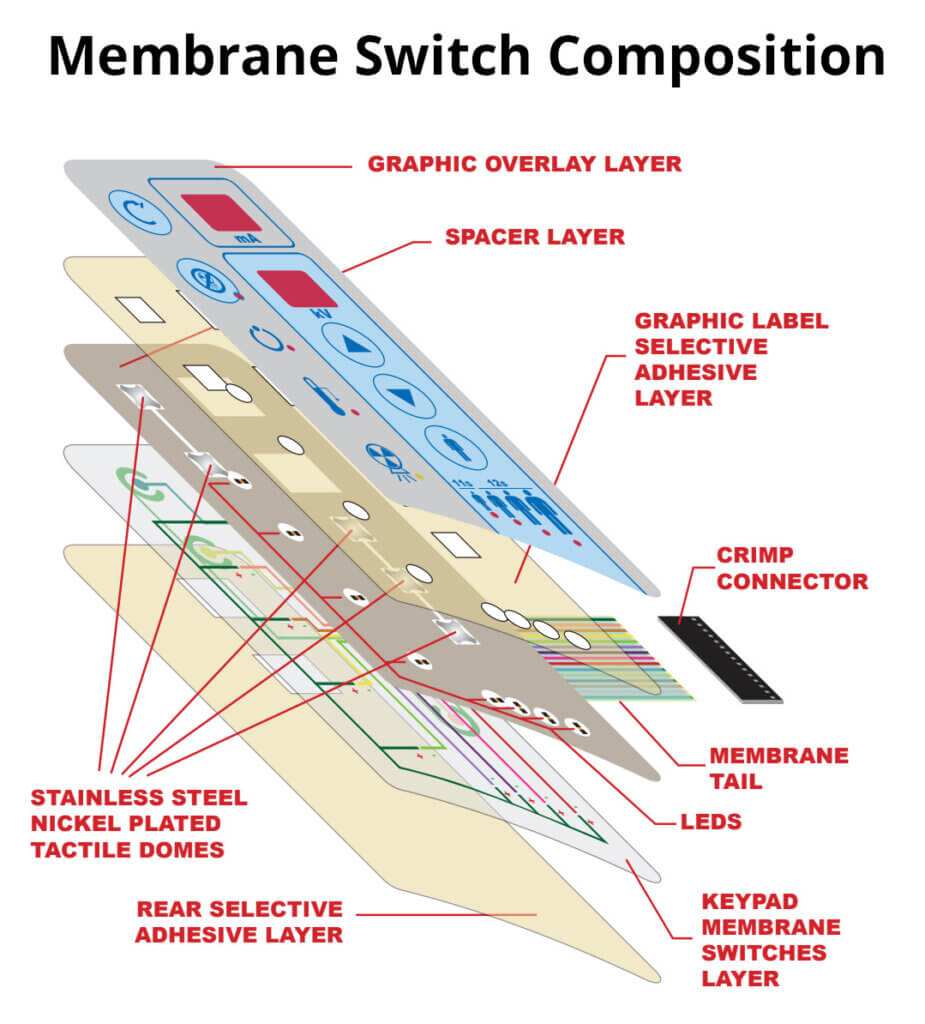Choosing the Right Membrane Switch for Your Business Needs
Choosing the Right Membrane Switch for Your Business Needs
Blog Article
Comprehending Membrane Layer Switches: The Trick to Reputable and sturdy Controls

What Are Membrane Switches?
Membrane buttons are a sophisticated option in the realm of user interface modern technology, incorporating functionality and style perfectly. These tools function as an interface between users and electronic systems, integrating a number of elements into a small style. Commonly constructed from versatile, slim layers of products, membrane layer buttons are made to react to touch, making it possible for customers to interact with equipment and digital tools properly.
The main aspects of a membrane switch consist of a published circuit layer, visuals overlay, and a spacer layer that protects against unintended activation. The visuals overlay can be tailored to show brand identity or customer preferences, boosting aesthetics while ensuring use. Membrane layer switches are typically used in various applications, including clinical gadgets, consumer electronic devices, and commercial devices, owing to their toughness and resistance to environmental factors such as dampness and dirt.
One of the essential benefits of membrane layer switches is their capacity to stand up to wear and tear, making them perfect for high-traffic environments. In addition, they are light-weight and require marginal area, allowing for ingenious designs in product advancement. In general, membrane layer switches over represent a useful and efficient option for modern-day electronic user interfaces, marrying modern technology with user-centric style concepts.
Exactly How Membrane Changes Work
The procedure of membrane layer switches hinges on a basic yet reliable mechanism that equates user input into electronic signals. When an individual presses the button, the leading layer flaws, enabling a conductive component in the circuit layer to make contact with a corresponding conductive pad on the underside of the graphic overlay.
The style of membrane layer switches can vary, but they usually include domes or tactile elements to give responses to the user, improving the general experience - membrane switch. The materials utilized in membrane layer switches, such as polyester or polycarbonate, contribute to their toughness and resistance to ecological variables, consisting of dampness and dirt. Additionally, the printed circuits are usually enveloped, which secures them from deterioration gradually.
Advantages of Membrane Layer Switches

Additionally, membrane layer switches are recognized for their sturdiness. Built from durable products, they are resistant to dirt, wetness, and physical wear, which dramatically expands their life-span contrasted to traditional mechanical switches. This sturdiness makes them especially appropriate for high-traffic settings and applications requiring longevity.
Another substantial advantage is the convenience of cleansing and upkeep. The smooth surface of membrane switches minimizes dirt accumulation and is often unsusceptible spills, making them perfect for settings that call for constant sanitization.
Moreover, membrane switches provide a streamlined account, bring about a thinner style that can be incorporated into different tools without including mass. This function not just boosts the visual appeal but additionally adds to a more ergonomic item layout.
Applications of Membrane Layer Switches
Functional and straightforward, membrane layer buttons discover applications throughout a variety of sectors, consisting of medical tools, consumer electronics, and commercial equipment. In the clinical field, these buttons are important to tools such as diagnostic equipment, person surveillance systems, and infusion pumps, where integrity and ease of cleansing are important. Their ability to keep and endure harsh settings visit this page functionality makes them excellent for such applications.

In customer electronic devices, membrane switches are utilized in items like microwaves, washing makers, and remotes - membrane switch. Their sleek style permits for intuitive interface, boosting the overall individual experience while supplying resilience and resistance to tear and put on
Commercial equipment likewise takes advantage of membrane layer buttons, specifically in control panels for machinery and automation systems. These buttons supply protection against dust and wetness, making sure regular performance in challenging environments. Moreover, their personalized attributes permit manufacturers to customize them to specific operational requirements, improving effectiveness and performance.
Selecting the Right Membrane Switch
When selecting a membrane button, it is essential to think about different elements that influence performance and viability for certain applications. The main considerations include environmental conditions, responsive comments, toughness, and style specs.
First, analyze the see page operating setting; buttons exposed to moisture, chemicals, or severe temperatures require details products to make sure durability and functionality. Next off, assess the need for responsive comments. Depending upon user communication, some applications may take advantage of a responsive reaction to this website validate activation, while others might choose a non-tactile layout for visual reasons.
Longevity is one more critical variable; membrane layer buttons should be made to stand up to frequent usage, impacts, and abrasion. Make certain the chosen button can withstand the anticipated lifecycle, especially in high-usage scenarios.

Verdict
In final thought, membrane layer switches over serve as necessary components in the style of trusted and durable control systems across different sectors. The versatility of membrane changes allows for tailored options that fulfill specific operational requirements, strengthening their value in modern-day technology.
Membrane changes represent an important facet of modern-day user interface design, blending functionality with resilience in different applications.Membrane switches are an advanced service in the realm of individual interface innovation, integrating capability and layout flawlessly. Commonly created from adaptable, slim layers of products, membrane layer switches are designed to react to touch, enabling individuals to interact with machinery and digital tools effectively.
The layout of membrane layer buttons can vary, but they frequently incorporate domes or tactile elements to provide responses to the customer, improving the general experience.In conclusion, membrane switches over serve as necessary parts in the layout of trustworthy and resilient control systems across numerous markets.
Report this page